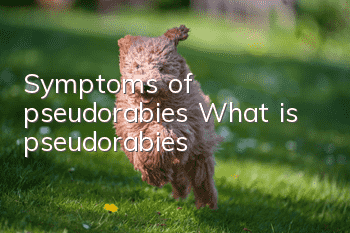Symptoms of pseudorabies What is pseudorabies

What is pseudorabies
Pseudorabies (pseudorabies) is caused by pseudorabies virus (Pseudorabies virus, PRV). It occurs in a variety of domestic and wild animals and is characterized by fever, itching and cerebrospinal problems. A disease in which inflammation is the main symptom. Because its symptoms were similar to those of rabies, it was once mistaken for rabies and later called pseudorabies.
【Pathogen】
PRV belongs to the Herpesviridae family, a linear double-stranded DNA virus. The virus has strong resistance and can survive in the external environment for several weeks, but it is sensitive to ether, chloroform, formalin and ultraviolet rays.
Epidemic characteristics of pseudorabies
The virus widely infects animals. Pigs, cattle, sheep, dogs, cats, rats, rabbits, mink, foxes and bears can all be infected. Studies have shown that pigs and rodents are the main reservoirs of viruses in nature, especially pigs. They are not only primary infected animals but also long-term reservoirs and detoxifiers of the virus. They are animals that cause disease in dogs, cats and other domestic animals. Pseudorabies in cats and dogs mainly occurs in pseudorabies endemic areas and is caused by eating the carcasses or meat of rats, pigs, and cattle that died of the disease.
Pseudorabies symptoms
Typical symptoms of infected dogs include sudden changes in behavior, muscle spasms, itching of the head and limbs, frantic biting of the itchy parts and howling. , jaw and pharyngeal paralysis and salivation, etc. The disease progresses rapidly, and death usually occurs within 48 hours of the onset of symptoms, with a mortality rate of 100%.
The incubation period of infected cats is 1 to 9 days. Early clinical symptoms include discomfort, lethargy, depression, restlessness, aggressive behavior, and resistance to touch. Later, symptoms develop rapidly, including excessive salivation, excessive swallowing, nausea, vomiting, and aimless screaming. In the later stages of the disease, more serious neurological symptoms such as hyperesthesia, Rubbing the face causes itching and self-biting. Typical symptoms are mostly acute, and death usually occurs within 36 hours. Atypical feline pseudorabies lacks the typical symptoms of severe itching.
[Pathological changes]
The main histological changes are diffuse pulmonary purulent meningitis, meningeal congestion, and increased cerebrospinal fluid (CSF). Intranuclear inclusions are found in neurons and astrocytes of diseased dogs and cats.
[Diagnosis]
Mainly based on contact history and clinical symptoms. Porcine pseudorabies diagnostic kit can also be used for diagnosis.
How to diagnose and treat pseudorabies
The main purpose is to control the epidemic of pseudorabies in pigs. At the same time, do not feed raw pork or improperly processed infected pork to dogs and cats. Also pay attention to proper disposal after rat eradication. The disease generally does not spread horizontally, and people are not susceptible to the virus.
- Is it better for Dogo dogs to have their ears erect or cropped? A case of Dogo dog’s ear erection surgery will tell you
- What do dogs eat to protect their stomach? It is important to protect their stomach and treat gastrointestinal diseases in dogs.
- How to tell if your dog is fat? Is your dog overweight?
- Will your dog catch a cold if you blow the air conditioner? What should you do if your dog catches a cold if you blow the air conditioner?
- What should you pay attention to when your dog drinks water? Don’t be careless when it comes to your dog’s drinking water.
- The dog's mouth bites and shakes. Why does the dog's mouth occasionally shake and bite?
- How to cut a dog's hair? Do you know how to cut a dog's hair correctly?
- Can dogs eat raw eggs? Why can’t dogs eat egg whites?
- Common Dog Problems in Summer How to Deal with Different Dog Problems
- How to keep dogs away from skin diseases. If you do this, will you see if your dog will still be infected with skin diseases?



